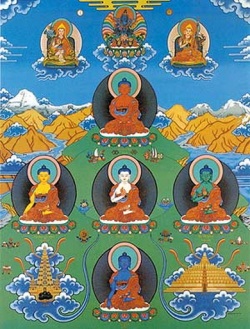The Five Buddha-Family Traits in Terms of the Five Types of Deep Awareness by Alexander Berzin
The Five Buddha-Family Traits in Terms of the Five Types of Deep Awareness
In terms of good qualities that are another aspect of the Aggregate of Consciousness (according to Gelug, the Aggregate of other affecting variables) - referring to the five types of deep awareness (ye-shes, five Buddha-wisdoms):
Vairochana represents the deep awareness of the sphere of reality (Skt. Dharmadhatu) (according to Gelug, mirror-like deep awareness).
Ratnasambhava represents the deep awareness of equalities.
Amitabha represents the deep awareness of individualities.
Amoghasiddhi represents accomplishing deep awareness.
Akshobhya represents mirror-like deep awareness (according to Gelug, the deep awareness of the sphere of reality).
The nineteen practices to bond closely (dam-tshig, Skt. Samaya) with the five Buddha-family traits and, specifically, with the five types of deep awareness:
Six to bond closely with reality awareness (Vairochana) (Gelug, mirror-like awareness):
Safe direction (Refuge) in the Three Jewels: the Buddhas, the Dharma, and the Arya Sangha. (Nyingma substitutes developing the aspiring and the engaged levels of Bodhichitta).
The three types of ethical self-discipline: restraining from destructive behavior, engaging in constructive actions such as Meditation, and helping Sentient beings.
Four to bond closely with equality awareness (Ratnasambhava):
The four types of Generosity: giving inner material objects such as our bodies, giving external material objects, giving Dharma, giving freedom from fear. (Gelug combines the first two into one and adds giving Love, the wish for everyone to have Happiness and the causes for Happiness).
Three to bond closely with individual awareness (Amitabha):
Upholding the teachings of the Sutra vehicles (Shravaka, Pratyekabuddha, and Bodhisattva), of the outer classes of tantra (kriya and charya), and of the confidential (secret) classes of tantra (yoga and anuttarayoga) (in Nyingma, yoga, mahayoga, Anuyoga, and Atiyoga or Dzogchen).
Two to bond closely with accomplishing awareness (Amoghasiddhi):
Making Offerings (Nyingma divides this into two closely bonding practices: Making Offerings in general and Making Offerings of tormas).
Safeguarding our vows (Nyingma substitutes engaging in activities such as pacifying Suffering and stimulating others' good qualities).
Four to bond closely with mirror-like awareness (Akshobhya) (Gelug, reality awareness):
Keeping a Vajra, and the clarity of appearing in pure appearances and the blissful awareness that it represents, as method.
Keeping a Bell, and the awareness of voidness it represents, as Wisdom.
Maintaining the mudra (seal) of visualizing ourselves as a Buddha-figure couple in union, representing the inseparable union of nondual method and Wisdom.
Committing ourselves properly to healthy relationships with our tantric masters.
When the five types of deep awareness are unpurified (mixed with unawareness of reality):
Reality awareness (Vairochana) (Gelug, mirror-like awareness) becomes naivety.
Equality awareness (Ratnasambhava) becomes arrogance and miserliness.
Individual awareness (Amitabha) becomes longing desire and Attachment.
Accomplishing awareness (Amoghasiddhi) becomes jealousy.
Mirror-like awareness (Akshobhya) (Gelug, reality awareness) becomes Anger.

